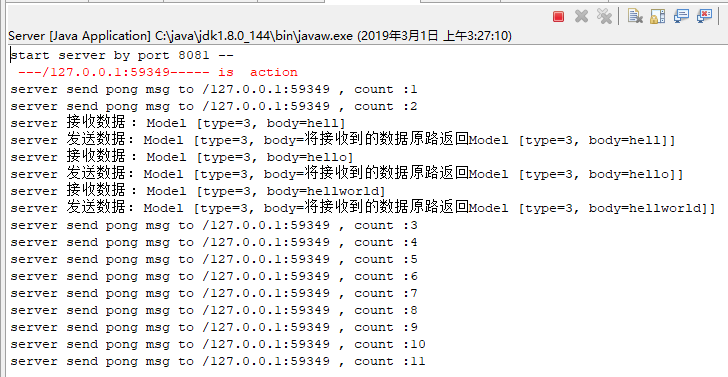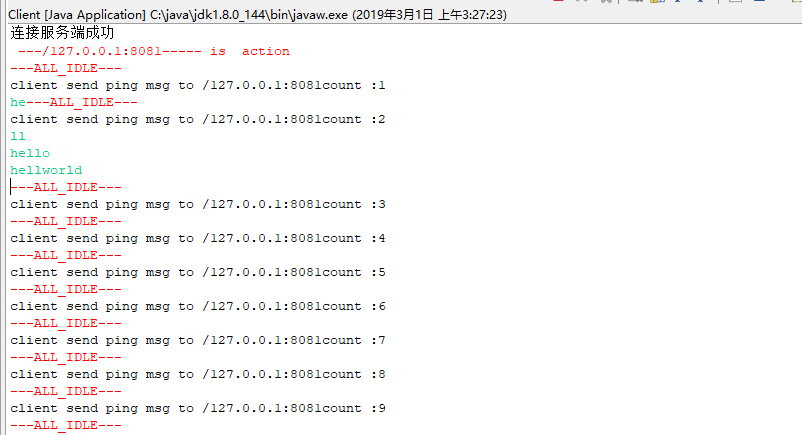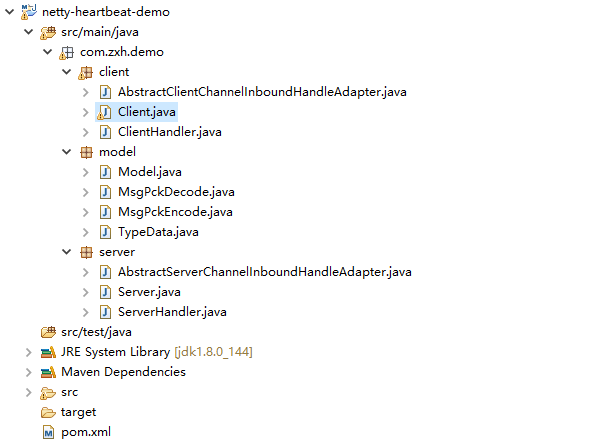基于netty实现的长连接,心跳机制及重连机制
概述
详细
详细
本篇demo实现的功能是基于netty的心跳机制和长连接以及重连机制,最关键的就是通过netty中的 IdleStateHandler 的超时机制来实现心跳和重连 ,然后通过org.msgpack编码器来实现跨平台数据传输,
实现的功能就是通过Scanner来输入消息得到服务端的回应,超过设定的超时时间就触发超时事件来进行心跳传输,如果服务端宕机客户端就会一直发起重连。
一、运行效果
服务端:

客户端:

二、实现过程
-
在maven pom文件添加依赖:
-
1234567891011121314
<!-- 解码and编码器 --><!-- https://mvnrepository.com/artifact/org.msgpack/msgpack --><dependency><groupId>org.msgpack</groupId><artifactId>msgpack</artifactId><version>0.6.12</version></dependency><!-- netty 核心依赖 --><!-- https://mvnrepository.com/artifact/io.netty/netty-all --><dependency><groupId>io.netty</groupId><artifactId>netty-all</artifactId><version>4.1.33.Final</version></dependency> -
12345678910111213
导入以上依赖↓创建配置模型model(模型类) , TypeData(参数配置类)↓创建解码and编码器MsgPckDecode(解码器) ,MsgPckEncode(编码器)↓创建各自的控制器 AbstractClientChannelInboundHandleAdapter,AbstractServerChannelInboundHandleAdapter↓创建客户端及客户端控制器Client(客户端启动类) , ClientHandler(客户端控制器)↓创建服务端以及控制器Server(客户端启动类) , ServerHandler(客户端控制器)ps:本demo使用了msgpack , It’s like JSON. but fast and small. -
1234567891011121314151617181920212223242526272829303132333435363738394041
package com.zxh.demo.model;import java.io.Serializable;import org.msgpack.annotation.Message;/*** 消息类型分离器* @author Administrator**/@Messagepublic class Model implements Serializable{private static final long serialVersionUID = 1L;//类型private int type;//内容private String body;public String getBody() {return body;}public void setBody(String body) {this.body = body;}public int getType() {return type;}public void setType(int type) {this.type = type;}@Overridepublic String toString() {return "Model [type=" + type + ", body=" + body + "]";}} -
1
编写一个配置类接口,用于控制心跳包和应用消息的处理 -
123456789101112131415
package com.zxh.demo.model;/*** 配置项* @author Administrator**/public interface TypeData {byte PING = 1;byte PONG = 2;//顾客byte CUSTOMER = 3;}创建MsgPckDecode(解码器)
-
123456789101112131415161718192021222324252627282930313233
package com.zxh.demo.model;import java.util.List;import org.msgpack.MessagePack;import io.netty.buffer.ByteBuf;import io.netty.channel.ChannelHandlerContext;import io.netty.handler.codec.MessageToMessageDecoder;/*** 解码器* @author Administrator**/public class MsgPckDecode extends MessageToMessageDecoder<ByteBuf>{@Overrideprotected void decode(ChannelHandlerContext ctx, ByteBuf msg,List<Object> out) throws Exception {final byte[] array;final int length = msg.readableBytes();array = new byte[length];msg.getBytes(msg.readerIndex(), array, 0, length);MessagePack pack = new MessagePack();out.add(pack.read(array, Model.class));}} -
1
创建MsgPckEncode(编码器) -
1234567891011121314151617181920212223242526
package com.zxh.demo.model;import org.msgpack.MessagePack;import io.netty.buffer.ByteBuf;import io.netty.channel.ChannelHandlerContext;import io.netty.handler.codec.MessageToByteEncoder;/*** 编码器* @author Administrator**/public class MsgPckEncode extends MessageToByteEncoder<Object>{@Overrideprotected void encode(ChannelHandlerContext ctx, Object msg, ByteBuf buf)throws Exception {// TODO Auto-generated method stubMessagePack pack = new MessagePack();byte[] write = pack.write(msg);buf.writeBytes(write);}} -
1
创建client客户端: -
123456789101112131415161718192021222324252627282930313233343536373839404142434445464748495051525354555657585960616263646566676869707172737475767778798081828384858687888990919293949596979899100101102103104105106107108109110111112
package com.zxh.demo.client;import java.util.Scanner;import java.util.concurrent.TimeUnit;import com.zxh.demo.model.Model;import com.zxh.demo.model.MsgPckDecode;import com.zxh.demo.model.MsgPckEncode;import com.zxh.demo.model.TypeData;import io.netty.bootstrap.Bootstrap;import io.netty.channel.Channel;import io.netty.channel.ChannelFuture;import io.netty.channel.ChannelFutureListener;import io.netty.channel.ChannelInitializer;import io.netty.channel.ChannelOption;import io.netty.channel.ChannelPipeline;import io.netty.channel.nio.NioEventLoopGroup;import io.netty.channel.socket.nio.NioSocketChannel;import io.netty.handler.timeout.IdleStateHandler;public class Client {private NioEventLoopGroup worker = new NioEventLoopGroup();private Channel channel;private Bootstrap bootstrap;public static void main(String[] args) {Client client = new Client();client.start();client.sendData();}private void start() {bootstrap = new Bootstrap();bootstrap.group(worker).channel(NioSocketChannel.class).option(ChannelOption.TCP_NODELAY, true).handler(new ChannelInitializer<Channel>() {@Overrideprotected void initChannel(Channel ch) throws Exception {// TODO Auto-generated method stubChannelPipeline pipeline = ch.pipeline();pipeline.addLast(new IdleStateHandler(0,0,5));pipeline.addLast(new MsgPckDecode());pipeline.addLast(new MsgPckEncode());pipeline.addLast(new ClientHandler(Client.this));}});doConnect();}/*** 连接服务端 and 重连*/protected void doConnect() {if (channel != null && channel.isActive()){return;}ChannelFuture connect = bootstrap.connect("127.0.0.1", 8081);//实现监听通道连接的方法connect.addListener(new ChannelFutureListener() {@Overridepublic void operationComplete(ChannelFuture channelFuture) throws Exception {if(channelFuture.isSuccess()){channel = channelFuture.channel();System.out.println("连接服务端成功");}else{System.out.println("每隔2s重连....");channelFuture.channel().eventLoop().schedule(new Runnable() {@Overridepublic void run() {doConnect();}},2,TimeUnit.SECONDS);}}});}/*** 向服务端发送消息*/private void sendData() {Scanner sc= new Scanner(System.in);for (int i = 0; i < 1000; i++) {if(channel != null && channel.isActive()){//获取一个键盘扫描器String nextLine = sc.nextLine();Model model = new Model();model.setType(TypeData.CUSTOMER);model.setBody(nextLine);channel.writeAndFlush(model);}}}} -
1
创建Server服务端: -
1234567891011121314151617181920212223242526272829303132333435363738394041424344454647484950
package com.zxh.demo.server;import com.zxh.demo.model.MsgPckDecode;import com.zxh.demo.model.MsgPckEncode;import io.netty.bootstrap.ServerBootstrap;import io.netty.channel.Channel;import io.netty.channel.ChannelFuture;import io.netty.channel.ChannelInitializer;import io.netty.channel.ChannelPipeline;import io.netty.channel.EventLoopGroup;import io.netty.channel.nio.NioEventLoopGroup;import io.netty.channel.socket.nio.NioServerSocketChannel;import io.netty.handler.timeout.IdleStateHandler;public class Server {public static void main(String[] args) {EventLoopGroup bossGroup = new NioEventLoopGroup(1);EventLoopGroup workerGroup = new NioEventLoopGroup(4);try {ServerBootstrap serverBootstrap = new ServerBootstrap();serverBootstrap.group(bossGroup, workerGroup).channel(NioServerSocketChannel.class).localAddress(8081).childHandler(new ChannelInitializer<Channel>() {@Overrideprotected void initChannel(Channel ch) throws Exception {// TODO Auto-generated method stubChannelPipeline pipeline = ch.pipeline();pipeline.addLast(new IdleStateHandler(10,0,0));pipeline.addLast(new MsgPckDecode());pipeline.addLast(new MsgPckEncode());pipeline.addLast(new ServerHandler());}});System.out.println("start server by port 8081 --");ChannelFuture sync = serverBootstrap.bind().sync();sync.channel().closeFuture().sync();} catch (InterruptedException e) {// TODO Auto-generated catch blocke.printStackTrace();}finally{//优雅的关闭资源bossGroup.shutdownGracefully();workerGroup.shutdownGracefully();}}}
先运行服务端,然后再启动客户端 会根据设置的端口连接服务端,在客户端输入消息就会得到服务端的回应,如果超过5秒没有进行读写就会触发IdleStateHandler类超时事件 来进行心跳包的传输 ,服务端未检测到客户端的读写或者心跳就会主动关闭channel通道
三、项目结构图

四、补充
所谓的心跳, 即在 TCP 长连接中, 客户端和服务器之间定期发送的一种特殊的数据包, 通知对方自己还在线, 以确保 TCP 连接的有效性.因为网络的不可靠性, 有可能在 TCP 保持长连接的过程中, 由于某些突发情况, 例如网线被拔出, 突然掉电等, 会造成服务器和客户端的连接中断. 在这些突发情况下, 如果恰好服务器和客户端之间没有交互的话, 那么它们是不能在短时间内发现对方已经掉线的. 为了解决这个问题, 我们就需要引入 心跳 机制. 心跳机制的工作原理是: 在服务器和客户端之间一定时间内没有数据交互时, 即处于 idle 状态时, 客户端或服务器会发送一个特殊的数据包给对方, 当接收方收到这个数据报文后, 也立即发送一个特殊的数据报文, 回应发送方, 此即一个 PING-PONG 交互. 自然地, 当某一端收到心跳消息后, 就知道了对方仍然在线, 这就确保 TCP 连接的有效性




【推荐】国内首个AI IDE,深度理解中文开发场景,立即下载体验Trae
【推荐】编程新体验,更懂你的AI,立即体验豆包MarsCode编程助手
【推荐】抖音旗下AI助手豆包,你的智能百科全书,全免费不限次数
【推荐】轻量又高性能的 SSH 工具 IShell:AI 加持,快人一步
· 10年+ .NET Coder 心语,封装的思维:从隐藏、稳定开始理解其本质意义
· .NET Core 中如何实现缓存的预热?
· 从 HTTP 原因短语缺失研究 HTTP/2 和 HTTP/3 的设计差异
· AI与.NET技术实操系列:向量存储与相似性搜索在 .NET 中的实现
· 基于Microsoft.Extensions.AI核心库实现RAG应用
· 10年+ .NET Coder 心语 ── 封装的思维:从隐藏、稳定开始理解其本质意义
· 地球OL攻略 —— 某应届生求职总结
· 提示词工程——AI应用必不可少的技术
· Open-Sora 2.0 重磅开源!
· 周边上新:园子的第一款马克杯温暖上架